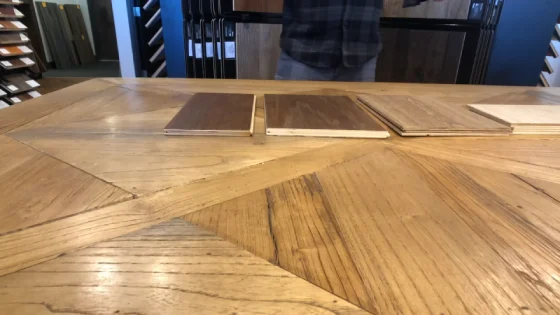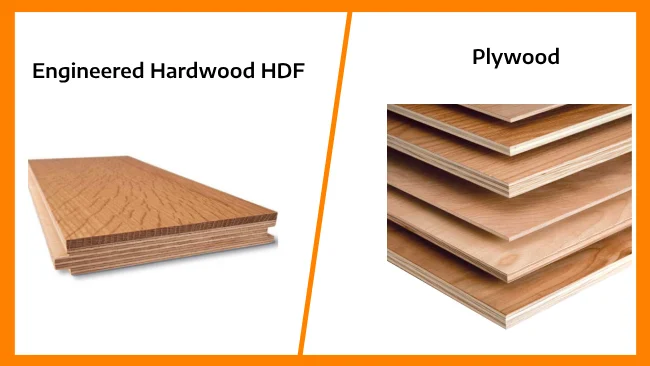Last Updated on August 1, 2023
Engineered hardwood is a popular choice in your home or office, but its core material determines its performance and longevity. Two common options for engineered hardwood cores are High-Density Fiberboard (HDF) and plywood.
HDF cores are composed of recycled hardwood, making them a more sustainable option. On the other hand, plywood cores consist of thin layers of wood compressed together, offering affordability.
Other differences exist between HDF and plywood cores in engineered hardwood flooring.
We will discuss the key differences between engineered hardwood flooring with HDF and plywood cores. Also, we will examine the maintenance and care requirements for both types of flooring, as well as their temperature tolerance and lifespan.
Differences Between Engineered Hardwood HDF and Plywood Core

HDF and plywood core in engineered hardwood differ in these categories:
- Material Composition
- Strength and Durability
- Moisture Resistance
- Expansion and Contraction
- Affordability
- Environmental Concerns
- Weight
Let’s take a closer look at the differences.
1. Material Composition
Both HDF and plywood cores have their unique material composition. HDF core is made from recycled hardwood, which makes it a more sustainable option than plywood core.
Conversely, the plywood core is made from thin layers of wood that are compressed together, resulting in a less dense core. This difference in material composition gives the HDF core a more uniform texture, providing better consistency in its finish.
2. Strength and Durability
In terms of strength and durability, HDF core outshines plywood core. HDF core is harder and more stable than plywood core, making it more resistant to warping, cracking, or cupping.
The HDF is an ultra-dense material with a high Janka hardness rating of 1700, making it more durable and resistant to wear and tear.
These characteristics make HDF core a preferred option for areas with high traffic and heavy footfall.
On the other hand, plywood cores are more susceptible to warping, cracking, or cupping over time.
Therefore, if you’re looking for a flooring option that can withstand the test of time and maintain its structural integrity, engineered hardwood with an HDF core is the ideal choice.
3. Moisture Resistance
HDF cores are more resistant to moisture than plywood cores. For areas with high humidity or water exposure, you’ll appreciate the superior moisture resistance of HDF. It ensures your floors won’t swell or warp.
High-Density Fiberboard is preferred for moisture-prone areas like bathrooms and kitchens. Its composition consists of wood fibers that are tightly compressed under high pressure, resulting in a dense and durable core. This dense core acts as a barrier against moisture, preventing the floor from absorbing water and causing damage.
In contrast, plywood cores are less moisture-resistant, making them more vulnerable to swelling, cupping, and warping in humid environments.
The difference in moisture resistance is due to the manufacturing process and composition of the two materials. HDF’s higher density and moisture-resistant properties make it ideal for high humidity or water exposure areas. It ensures long-lasting and reliable flooring.
4. Expansion and Contraction
The uniform density and thickness of the HDF core make it a better choice for engineered wood flooring, especially for larger planks with wider widths and lengths.
This property enhances the performance of the HDF core in terms of resistance to expansion and contraction over time.
HDF core flooring is more forgiving in fitting into spaces with constraints and is easier to install over various types of subfloors with click-and-lock technology.
Conversely, plywood cores are more prone to expanding and contracting issues, especially in environments with fluctuating temperatures and high humidity.
5. Affordability
The plywood core is more affordable than the HDF core. With its more budget-friendly price, opting for a plywood core for your engineered wood flooring allows you to enjoy both affordability and functionality.
While HDF offers a smoother and more uniform surface, it is generally more expensive than plywood. When it comes to cost-effectiveness, plywood is the clear winner. It offers a reliable and durable option for those looking for a more affordable engineered wood flooring solution.
6. Environmental Concerns
HDF may have environmental concerns due to off-gassing when using resin in its production. HDF is typically manufactured using a combination of wood fibers and resins, which may contain formaldehyde or other chemical additives.
Formaldehyde is a volatile organic compound (VOC) that can be released into the air over time, contributing to indoor air pollution.
Off-gassing refers to the release of gasses or chemicals from a material into the surrounding environment.
In the case of HDF, there can be concerns about the emission of formaldehyde or other volatile substances during manufacturing or even after installation in homes or commercial spaces.
These emissions can adversely affect indoor air quality, potentially leading to respiratory problems or allergic reactions in sensitive individuals.
In contrast, plywood cores generally have fewer environmental concerns compared to HDF. Plywood is made by bonding thin layers of wood together, typically with adhesives.
While there may still be some emissions from the adhesives used, plywood generally has lower VOC emissions than HDF. Additionally, plywood can be manufactured from sustainably sourced wood, further reducing its environmental impact.
7. Weight
HDF cores are heavier than plywood cores in terms of weight. Surprisingly, the heavier weight of HDF cores actually adds a sense of stability and durability to the flooring. Engineered hardwood with HDF cores is known for its high density, which contributes to its strength and resilience.
In contrast, plywood cores are lighter in weight, but they may not offer the same level of durability as HDF cores. Plywood is made by stacking multiple layers of wood veneers and bonding them together with adhesive.
While plywood is generally more lightweight, it may be more prone to damage and wear over time. Therefore, engineered hardwood with HDF cores is a reliable choice if you’re seeking stability and long-lasting performance.
Comparison Table Between Engineered Hardwood HDF vs Plywood
Here’s a comparison table highlighting the key differences between HDF (High-Density Fiberboard) and plywood cores in engineered hardwood flooring:
| Aspect | HDF Core | Plywood Core |
| Material Composition | Made from recycled hardwood, more sustainable | Made from thin layers of wood |
| Strength and Durability | Harder and more stable, resistant to warping and cracking | Less dense, more prone to warping and cracking |
| Moisture Resistance | More moisture-resistant, suitable for high-humidity areas | Less moisture-resistant, prone to swelling and warping |
| Expansion and Contraction | Offers uniform density, performs well in various conditions | More prone to expanding and contracting issues |
| Affordability | Typically more expensive than plywood core | More affordable option |
| Weight | Heavier due to higher density | Lightweight |
Maintenance and Care For HDF and Plywood Core Engineered Hardwood Flooring

There are several key points to keep in mind when maintaining and caring for HDF and plywood-core engineered hardwood flooring.
1. Regular Cleaning
To keep your engineered hardwood floors looking their best, make sure to regularly sweep or vacuum with a soft-bristle broom or a vacuum attachment designed specifically for HDF/plywood floors.
This will help remove dust, dirt, and debris accumulating over time and potentially scratching the surface.
2. Gentle Mopping
For gentle mopping, following the proper cleaning guidelines for engineered hardwood HDF and plywood floors is essential. A damp mop or microfiber cloth should be slightly moistened with a recommended HDF/plywood hardwood floor cleaner. Excessive water should be avoided as it can potentially damage the wood.
By adhering to this method, you can effectively remove dirt and grime without compromising the integrity of the flooring. Remember to wipe up any spills to prevent staining or warping promptly.
This regular cleaning routine will help maintain the beauty and longevity of your engineered hardwood HDF or plywood floors.
3. Avoid Harsh Cleaners
If you want to keep your floors looking their best, make sure to steer clear of any harsh cleaners, as they can cause damage to the finish and surface of the wood.
Instead, opt for gentle cleaning agents that are specifically formulated for hardwood floors. These cleaners are designed to remove dirt and grime efficiently without damaging the wood.
4. Protective Measures
Ensure the longevity and beauty of your floors with these simple yet effective protective measures. Place mats or rugs at entryways to trap dirt and prevent scratches, while felt pads affixed to furniture legs will prevent scratching during movement or rearrangement.
5. Avoid Excessive Moisture
Excessive moisture must be avoided to prevent potential damage to hardwood flooring with a HDF or plywood core. Excessive moisture can penetrate the wood layers, leading to swelling, warping, or cupping of the floorboards. Here are some important points to consider regarding moisture avoidance:
- Spills: Clean up spills immediately to prevent moisture from seeping into the flooring. Use a soft cloth or paper towel to absorb the liquid gently. Avoid using excessive water or wet mops, as they can saturate the wood.
- Wet Cleaning: When cleaning the floor, use a damp mop or microfiber cloth that is only dampened with a hardwood floor cleaner recommended for HDF/plywood floors. It is important to wring out excess water to ensure the mop or cloth is not dripping wet.
- Water Sources: Take precautionary measures to avoid water sources near the engineered hardwood flooring. Be mindful of water splashes, leaks, or excessive humidity in areas like kitchens, bathrooms, or laundry rooms. Use mats or rugs in such areas to provide additional protection.
- Humidity Control: Maintain stable humidity levels within the recommended range for the specific flooring product. High humidity may cause the wood to absorb moisture and expand, whereas low humidity may lead to shrinking and gapping between the boards. Use a humidifier or dehumidifier, if necessary, to regulate indoor humidity levels.
- Subfloor Moisture: Ensure that the subfloor is dry and properly prepared before installing the engineered hardwood flooring. Moisture barriers or underlayment materials may be necessary to prevent moisture from migrating from the subfloor to the flooring.
What is the temperature tolerance of HDF-core engineered hardwood flooring?

The recommended temperature range for HDF-core engineered hardwood flooring in residential environments is approximately 17-23°C (62-73°F).
This range ensures that the wood remains stable and avoids excessive expansion or contraction. Maintaining a relative humidity level of 45-60 percent is crucial to prevent any adverse effects on the flooring.
What is the lifespan of plywood core engineered hardwood flooring?
The longevity of plywood core engineered hardwood flooring is greatly influenced by several factors, such as the quality of the flooring, installation methods, maintenance practices, and level of foot traffic.
With proper care and maintenance, such flooring can typically survive for 25-30 years. This durability makes it an attractive option for homeowners seeking a long-term flooring solution. However, the exact lifespan of the flooring can vary depending on how well it is installed and maintained.
Therefore, it is essential to work with a professional installer and follow the recommended maintenance guidelines to maximize the lifespan of your engineered hardwood flooring.
Make the Right Engineered Hardwood Flooring Choice Between HDF and Plywood
So, when comparing HDF and plywood-core engineered hardwood flooring, it’s important to consider factors such as sustainability, durability, moisture resistance, affordability, and ease of installation.
HDF core flooring offers a more sustainable and durable option with better moisture resistance, while plywood core flooring is more affordable and versatile.
Both types require regular cleaning and maintenance; temperature and humidity control are essential. Ultimately, the choice depends on individual preferences and specific project needs.

